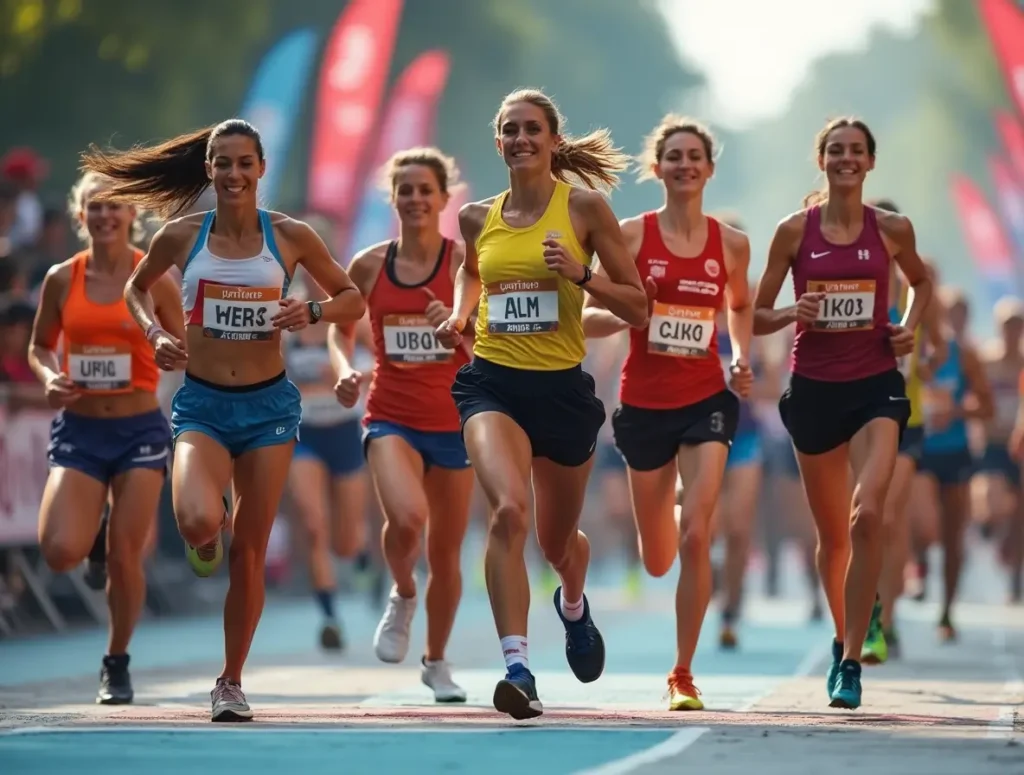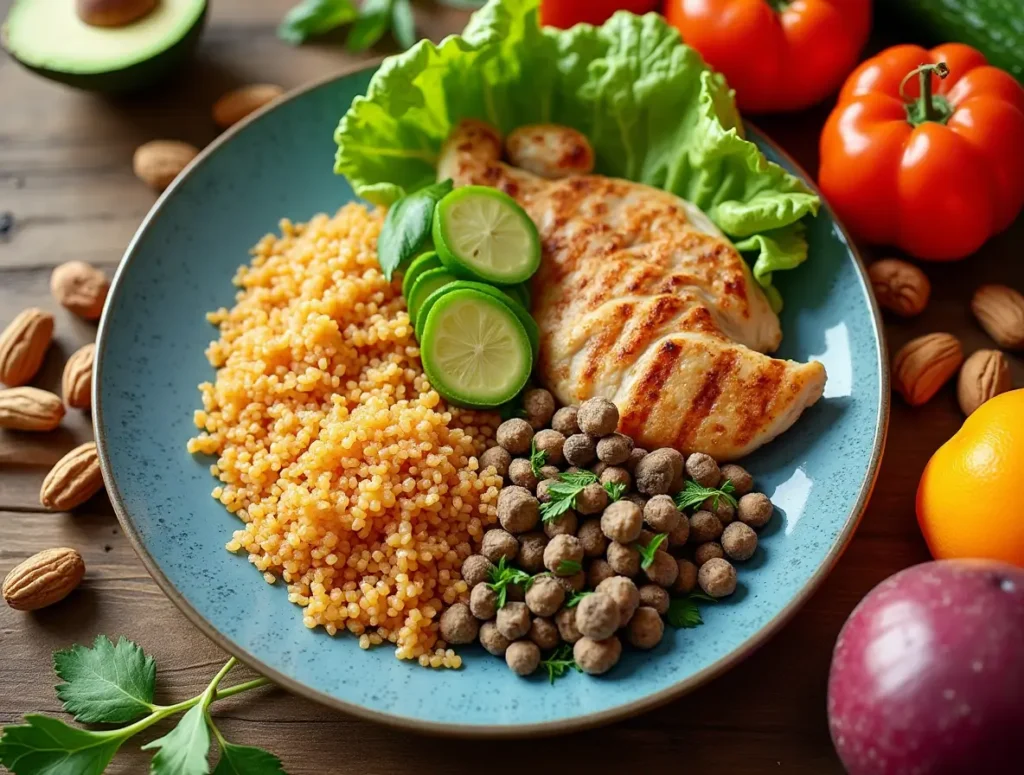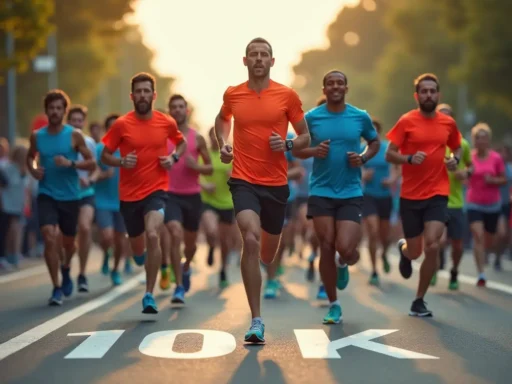Thinking about running a 10K marathon? You might wonder, how many miles is it? A 10K run is 6.2 miles, which can seem tough for newbies. Knowing the distance and how to prepare is key to your success.

Running a 10K at a 10-minute mile pace takes about 1 hour and 2 minutes. This is a good goal for beginners. It lets you aim for something achievable and work towards it. Knowing the distance helps you train better, making sure you’re ready for the challenge.
Table of Contents
Understanding the 10K Marathon Distance
The 10K marathon distance is about understanding kilometers to miles. The “k” in 10K stands for kilometers. So, 1 kilometer is about 0.6 miles. This makes a 10K roughly 6.2 miles.
For a 10K, the average time for a casual runner is 40 to 60 minutes. Top runners can finish in under 30 minutes for men and under 37 minutes for women.
Converting Kilometers to Miles
Converting kilometers to miles is easy. Just multiply the number of kilometers by 0.6. For example, a 10K race is 6.2 miles.
Why the 10K Is Called a Marathon
The term “marathon” usually means a 42.195-kilometer race. But, the 10K is also called a marathon sometimes. It’s important to know the 10K marathon distance is its own event.
Historical Background of the 10K Race
The 10K race has a long history, starting in the late 19th century. Today, it’s a favorite for runners of all levels. It’s a great challenge for those aiming to beat their personal best.
Benefits of Running a 10K Distance
Running a 10k is a great challenge for beginner runners. It’s exciting and pushes you to do your best. The benefits of running a 10k include better heart health, stronger muscles, and a happier mind.
Some of the key benefits of running a 10k include:
- Weight loss and improved body composition
- Improved mood and reduced stress and anxiety
- Better sleep quality and overall mental well-being
- Opportunities for personal best (PB) achievements
Running a 10k is a stepping stone to longer races like half marathons or marathons. With the right training and effort, anyone can finish a 10k. They’ll enjoy the many benefits of running a 10k.
Essential Gear for Your 10K Training Journey
Getting ready for your 10K marathon means having the right gear. The right gear can greatly improve your performance and experience. A good pair of running shoes, for instance, can prevent injuries and make running more efficient.
Moisture-wicking clothing is also key for 10K training. It keeps you dry and comfy, even when you’re pushing hard. Don’t forget a water bottle or hydration pack, a running watch or fitness tracker, and comfy socks.
| Essential Gear | Description |
|---|---|
| Running Shoes | Good quality shoes that provide support and cushioning |
| Moisture-Wicking Clothing | Clothing that helps to keep you dry and comfortable |
| Water Bottle or Hydration Pack | A convenient way to stay hydrated during long runs |
Investing in the right gear for 10K training is crucial. It ensures a successful and fun 10K marathon. Choose gear that’s comfy, functional, and fits your needs and preferences.

10K Marathon Is How Many Miles: The Complete Breakdown
Running a 10K marathon is a big deal. You might wonder, 10k marathon is how many miles ? It’s 6.2 miles. This distance is a big goal for many runners.
For those aiming to run a 10K, knowing the distance is key. It’s a popular race among runners. Understanding the distance helps with training and getting ready.
Here are some important facts about the 10K marathon distance:
- A 10K marathon is equivalent to 6.2 miles.
- The average finish time for a 10K race can vary significantly, depending on the runner’s pace and experience.
- A good 10K time ranges from 30 minutes for elite runners to 70+ minutes for newer runners.
Knowing the distance of a 10K marathon helps runners prepare. Whether it’s your first 10K or you’re trying to get faster, knowing the distance is crucial. So, a 10K marathon is 6.2 miles.
Building Your Base Fitness for a 10K
To do well in a 10K, you need to build a strong base fitness. This includes getting your heart rate up, strengthening your muscles, and improving your flexibility. This foundation is key for 10K training, helping you meet the race’s demands and perform your best.
Creating a structured training plan is crucial for building base fitness for a 10K. Your plan should mix running, strength exercises, and rest days. For example, if you run 25-30 miles a week, aim for 35-40 miles for 10K training. Beginners should aim for 8-10 mile long runs, while more experienced runners can go up to 10-12 miles.
Key Components of Base Fitness
The main parts of base fitness for a 10K are:
- Cardiovascular conditioning: This means improving your endurance through running and aerobic exercises.
- Strength training: This boosts your running efficiency and lowers injury risk.
- Flexibility and mobility work: These exercises enhance your range of motion and reduce injury risk.
By adding these elements to your training, you’ll be well-prepared for a 10K marathon. Stay consistent, listen to your body, and adjust your training as needed. This will help you get the most out of your 10K training.
| Training Component | Beginner | Intermediate | Advanced |
|---|---|---|---|
| Weekly Mileage | 35-40 miles | 40-50 miles | 50-60 miles |
| Longest Run | 8-10 miles | 10-12 miles | 12-15 miles |
| Strength Training | 2 sessions/week | 2-3 sessions/week | 3 sessions/week |
Creating Your Training Schedule
Getting ready for a 10k marathon means making a solid training plan. This plan should mix running, rest, and other exercises. It helps build endurance and keeps you injury-free. A good 10k training plan has three to five runs a week, with a longer run on weekends.
To make a 10k training plan, start by setting achievable goals and tracking your progress. Use a running log or a mobile app to record your runs. It’s vital to listen to your body and adjust your plan if needed. If you’re feeling tired or in pain, it’s okay to take a day off or change your workout.
Here are some tips for your 10k training schedule:
- Begin with shorter runs and gradually increase the distance and intensity
- Include rest days and cross-training to avoid burnout and prevent injury
- Have a mix of easy, moderate, and hard runs to boost endurance and speed
- Always warm up and cool down before and after each run
Remember, being consistent and patient is key when training for a 10k marathon. Stick to your plan, listen to your body, and believe in yourself. You’ll be ready to conquer your 10k in no time.
| Week | Monday | Tuesday | Wednesday | Thursday | Friday | Saturday | Sunday |
|---|---|---|---|---|---|---|---|
| 1 | 3 miles easy | Rest | 3 miles moderate | Rest | 3 miles easy | 5 miles long run | Rest |
| 2 | 3.5 miles easy | Rest | 3.5 miles moderate | Rest | 3.5 miles easy | 6 miles long run | Rest |
Nutrition and Hydration Strategies
Getting ready for your 10K marathon training means focusing on nutrition and hydration. These are key to performing well over the 6.2-mile distance. A good plan for eating and drinking can greatly improve your performance and recovery.
It’s important to think about what works best for you when it comes to nutrition and hydration for 10k. Adequate hydration is key to avoid dehydration and perform at your best. Drink about 300 ml of water every 15 minutes during long activities. You can check if you’re drinking enough by looking at your urine color.

Pre-Race Meal Planning
A meal with complex carbs, protein, and healthy fats can give you energy for your 10K. Choose a meal that’s rich in carbs, has some protein, and is low in fat and fiber.
During-Race Fueling
It’s important to keep your energy up and stay hydrated during the race. Try to eat 120-150 calories of carbs per hour. Also, drink 300-400 ml of water every 15-20 minutes. Energy gels or sports drinks can help with electrolytes and quick energy.
Post-Run Recovery Nutrition
After the race, eat a mix of carbs and protein to help your body recover. Aim for a meal with 3:1 or 4:1 carbs to protein ratio within 30-60 minutes. This helps with muscle recovery and energy replenishment.
By using these nutrition and hydration tips for 10k in your training, you can improve your performance and stay healthy. Remember to drink plenty, eat the right foods, and listen to your body for the best results.
Common 10K Training Mistakes to Avoid
Training for a 10k marathon requires avoiding common mistakes. Overtraining and inadequate recovery are major pitfalls. These can slow your progress and raise injury risks.
To sidestep these errors, rest days are key. Also, focus on proper nutrition and hydration. A diet rich in carbs, protein, and fats boosts performance. Drinking water or electrolyte drinks on long runs prevents dehydration.
Here are some common 10k training mistakes to avoid:
- Not warming up properly before each run
- Not incorporating strength training into your routine
- Not replacing running shoes regularly
- Not starting runs at a manageable pace
- Not having a post-race recovery plan
Avoiding these mistakes ensures a successful and injury-free 10k marathon training. Stay focused, listen to your body, and prioritize health.
| Mistake | Consequence | Prevention |
|---|---|---|
| Overtraining | Injury, burnout | Incorporate rest days, prioritize recovery |
| Inadequate nutrition | Poor performance, dehydration | Prioritize balanced diet, stay hydrated |
| Poor pacing | Burnout, poor performance | Start runs at a manageable pace |
Race Day Preparation Tips
Getting ready for your 10k marathon is key. Focus on race day tips to have a great time. A good morning routine, pacing, and mental prep are crucial.
Begin with a morning plan, including a light meal or snack. Drink 8 glasses of water or sports drink the day before. On race day, have 6-10 ounces of fluid 2-3 hours before starting.
Here are more tips to think about:
- Avoid too much water to cut down on bathroom stops during the race
- Pin your race bib in the front with 2-4 safety pins
- Drink an electrolyte beverage the night before to stay hydrated
- Don’t drink alcohol the night before to avoid dehydration
By following these tips, you’ll be ready for your 10k marathon. Stay focused, pace yourself, and trust your training to reach your goals.
| Tips | Description |
|---|---|
| Morning Routine | Plan a light meal or snack, and stay hydrated with 8 glasses of water or sports drink the day before the race |
| Pacing Strategies | Start with a controlled effort, maintain a steady pace, and finish strong |
| Mental Preparation | Stay focused, trust your training, and visualize your success |
Recovery and Post-Race Care
After finishing a 10k marathon, it’s key to focus on recovery and post-race care. This helps prevent injuries and reduces muscle soreness. Techniques like stretching and foam rolling can ease muscle tightness and boost performance.
A good recovery plan is vital for runners. It helps avoid overtraining and keeps you performing at your best. Experts say recovery time for a 10k is shorter than for a marathon, usually just a few days.
However, it’s wise to take 2-3 weeks off between races. This ensures full recovery and prevents overtraining. Light jogging after the race can also help. It’s best to jog a bit faster than walking.
Listening to your body and addressing muscle tightness is crucial. Stretching and massage can prevent further injury. Here are some recovery tips for a 10k marathon:
- Stay hydrated with water and electrolyte-rich fluids
- Eat a balanced meal with carbs and protein within 30-60 minutes after the race
- Do light stretching and foam rolling to reduce soreness
- Get enough rest and sleep for your body to recover
By focusing on recovery and post-race care, you can recover from a 10k marathon. This way, you’ll be ready for your next race. Always listen to your body and take the time you need to recover. If you have concerns, don’t hesitate to seek advice from a medical professional or running coach.
Conclusion
Starting your 10K marathon journey is exciting. The real win isn’t just about the time. It’s about the feeling of achievement and growth you’ll gain.
Whether you’re a pro or new to running, finishing a 10K is a big deal. It’s a moment to be proud of.
The 10K is a great mix of challenge and fun. It pushes you to do better and feels amazing when you finish. With good training, the right gear, and a positive attitude, you can conquer the 6.21 miles.
At 10K events, you’ll find a community of runners. Everyone supports each other and celebrates their love for running. It’s more than a race; it’s a chance to make friends and memories.
Get ready for your 10K by staying focused and consistent. Believe in yourself and your training. You’ll find the rewards of this distance, both in body and mind. Finish with pride, knowing you’ve done something special.
FAQ
What is the distance of a 10K marathon?
A 10K marathon is 6.2 miles or 10 kilometers. The “10K” refers to the distance, which is 10 kilometers or approximately 6.2 miles.
How do I convert kilometers to miles for a 10K marathon?
To convert kilometers to miles for a 10K marathon, use the conversion factor of 1 kilometer being equal to 0.62 miles. So, 10 kilometers is equivalent to approximately 6.2 miles.
Why is a 10K race called a “marathon”?
The term “marathon” comes from the legend of Pheidippides, who ran from Marathon to Athens to announce a Greek victory. While a traditional marathon is 26.2 miles, the 10K race is also called a “marathon” because it’s a challenging distance for many runners.
What are the benefits of running a 10K distance?
Running a 10K distance is a great challenge for beginner runners. It offers a sense of accomplishment and excitement. The distance is long enough to test your endurance but not as daunting as a full marathon.
What essential gear do I need for 10K training?
For 10K training, you’ll need high-quality running shoes, moisture-wicking clothing, and training accessories. These include heart rate monitors, GPS watches, and foam rollers. Proper gear is key for comfort, injury prevention, and optimal performance.
How do I build a strong base fitness for a 10K?
Building a strong base fitness for a 10K involves cardiovascular conditioning, strength training, and flexibility/mobility work. This well-rounded approach helps develop the endurance, strength, and physical preparedness needed to train for and complete a 10K race.
How do I create an effective training schedule for a 10K?
To create an effective training schedule for a 10K, set realistic goals and gradually increase your mileage and intensity. Adjust the schedule as needed based on your progress and any changes in your fitness level or training needs.
What are the key nutrition and hydration strategies for a 10K?
Proper nutrition and hydration strategies for a 10K include planning your pre-race meals, fueling during the race, and focusing on recovery nutrition after the run. This holistic approach helps maintain energy levels, optimize performance, and support your body’s recovery.
What common mistakes should I avoid during 10K training?
Common mistakes to avoid during 10K training include overtraining, inadequate recovery, poor nutrition, and ignoring the importance of base fitness. Recognizing and addressing these pitfalls can help you train effectively and avoid setbacks.
How should I prepare for the 10K race day?
Effective race day preparation for a 10K includes having a consistent morning routine, practicing optimal pacing strategies, and mentally preparing yourself for the challenge. These elements can help you feel confident and perform your best on race day.
What are the key recovery and post-race care practices for a 10K?
After completing a 10K, focus on proper recovery practices like stretching, foam rolling, and a post-run nutrition plan. These steps help your body recover, reduce the risk of injury, and prepare you for your next training session or race.




